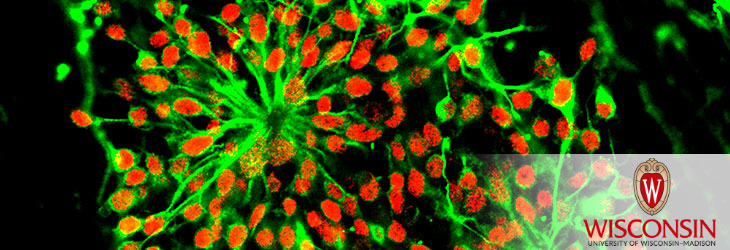Pluripotent Stem Cells

Hydrogel Arrays for Screening Cell-Substrate Interactions
WARF: P140097US01
Inventors: William Murphy, Stefan Zorn, Ngoc Nhi T. Le, Michael Schwartz, Eric Nguyen
The Wisconsin Alumni Research Foundation (WARF) is seeking commercial partners interested in developing patterned hydrogel arrays featuring individually controlled spots.
Overview
While extensive research has been devoted to understanding the influence of medium conditions on cell development, researchers have only recently begun to understand the role of culture surface properties. Self-assembled monolayer (SAM) substrates are a valuable tool in this process, enabling researchers to systematically expose cells to various surface-bound molecules — such as proteins, nucleic acids and polysaccharides — and analyze how these molecules influence cell behavior.
However, SAM technology has yet to become commonplace for cell biologists because preparing arrays is labor intensive (a typical experiment may require close to a thousand handling steps). Therefore, simplified preparation methods are needed to make SAMs a more practical tool.
However, SAM technology has yet to become commonplace for cell biologists because preparing arrays is labor intensive (a typical experiment may require close to a thousand handling steps). Therefore, simplified preparation methods are needed to make SAMs a more practical tool.
The Invention
UW–Madison researchers developed a new method for forming patterned hydrogel arrays featuring any number of test spots possessing different characteristics, such as shape and chemical composition. The arrays can be used to culture a range of cell types and rapidly analyze their behavior (e.g., attachment, spreading, proliferation and differentiation).
The arrays are prepared using a hydrogel precursor solution containing a polymer and crosslinker. The solution is sandwiched between stenciled SAM layers containing hydrophilic (‘water-loving’) and hydrophobic (‘water-hating’) regions, then polymerized and released.
As a result of the process, the array features hydrophilic spots surrounded and isolated by hydrophobic regions, preventing any mixing of contents. The spots can have any desired shape, size and chemical composition.
The arrays are prepared using a hydrogel precursor solution containing a polymer and crosslinker. The solution is sandwiched between stenciled SAM layers containing hydrophilic (‘water-loving’) and hydrophobic (‘water-hating’) regions, then polymerized and released.
As a result of the process, the array features hydrophilic spots surrounded and isolated by hydrophobic regions, preventing any mixing of contents. The spots can have any desired shape, size and chemical composition.
Applications
- Research tool for 2-D and 3-D assays, stem cell culture and drug discovery
- May be used with common microarray add-ons of different sizes and shapes consistent with those of typical multiwell plates (e.g., 96 and 384 well plates, etc.)
- Useful with multichannel pipettes for enhanced-throughput cell culture, media exchange, etc.
Key Benefits
- Cost-effective fabrication
- Easier to make and use
- Permits independent control over the content and dimensions of each spot in the array
- Compatible with a wide range of cell and ligand types
- Supports enhanced throughput
Stage of Development
The researchers have developed PEG (polyethylene glycol) hydrogel arrays formed using alkanethiolate SAMs on gold substrates.
Additional Information
For More Information About the Inventors
Related Technologies
Publications
For current licensing status, please contact Rafael Diaz at [javascript protected email address] or 608-960-9847
- Hansen et al. 2014. Biomaterial Arrays with Defined Adhesion Ligand Densities and Matrix Stiffness Identify Distinct Phenotypes for Tumorigenic and Non-Tumorigenic Human Mesenchymal Cell Types. J. Biomat. Sci. 5, 745-756.